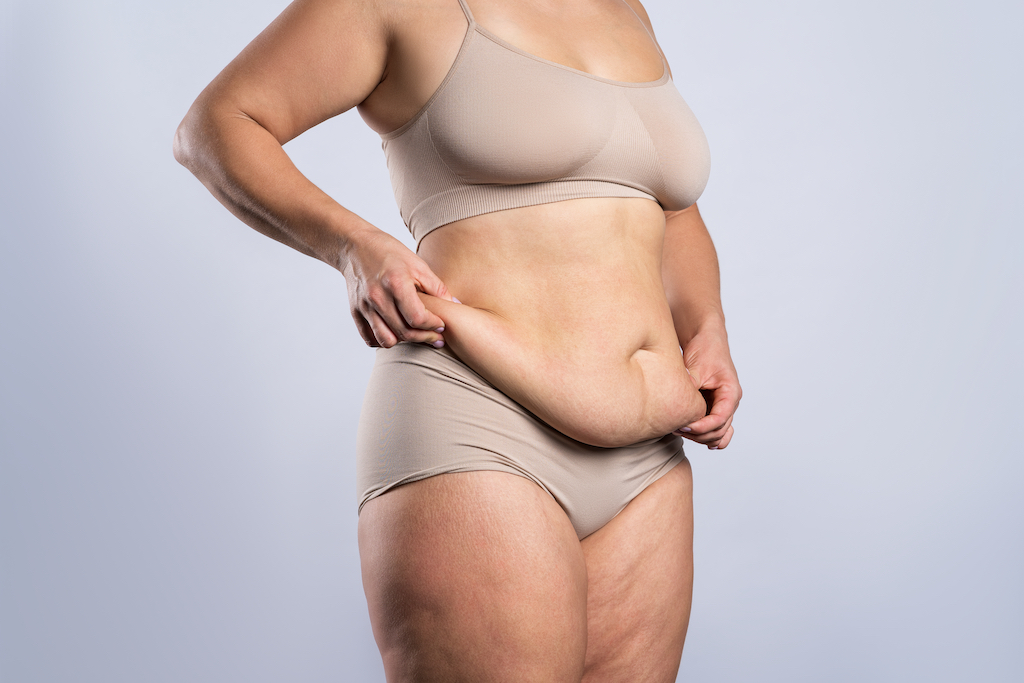 Photo Credit: Courtesy of staras/ShutterstockWhen skin is stretched by the body’s weight for a long period of time, it naturally becomes more extended and can lose its elasticity. This is a result of damaged collagen and elastin fibers (Sami et al). When weight is lost, it is common for there to be excess skin in certain areas of the body such as the abdomen, breast, chest, upper arms, thighs, and buttocks (Marek et al). Here Haute Beauty expert Dr. Samuel Lin and Iulianna C. Taritsa, BA, explore the root causes of loose skin, potential side effects of excess skin, and comprehensive treatment options.
Photo Credit: Courtesy of staras/ShutterstockWhen skin is stretched by the body’s weight for a long period of time, it naturally becomes more extended and can lose its elasticity. This is a result of damaged collagen and elastin fibers (Sami et al). When weight is lost, it is common for there to be excess skin in certain areas of the body such as the abdomen, breast, chest, upper arms, thighs, and buttocks (Marek et al). Here Haute Beauty expert Dr. Samuel Lin and Iulianna C. Taritsa, BA, explore the root causes of loose skin, potential side effects of excess skin, and comprehensive treatment options.
Factors That Cause Excess Skin
While this process is a normal part of dramatic or chronic obesity and subsequent weight loss, there are some factors that may make the degree of excess skin greater. These include the length of time that the skin had been stretched out (the longer the time, the higher the risk of large amounts of excess) and the amount of weight lost (more weight loss leads to more excess skin). Age can also affect the skin’s elasticity, and it has been shown that older individuals may have more excess skin after rapid weight loss compared to younger individuals due to the loss of collagen as people age (Quan et al). Sun exposure over time causes damage to the skin’s collagen networks and elastin production which can also lead to loose skin after weight loss (Rittié et al, Kang et al). Smoking is another cause of decreased skin collagen production and damage to existing collagen, leading to more excess skin (Beylot). Finally, there may be some genetic component that predisposes to the amount of collagen and elastin production in the skin that can affect an individual’s chance of developing loose skin after weight loss.
The Possible Side Effects of Loose Skin
The side effects caused by loose skin after massive weight loss can depend on the degree and amount of excess skin. For most people with less severe amounts of excess skin, the effects do not pose any physical threat. Sagging skin in certain areas may still be a psychosocial challenge in these patients. For example, it may cause emotional distress or dissatisfaction with their appearance that may lead to difficulties engaging in public spaces where the skin is shown, or discomfort during physical activity or sexual behavior (Marek et al., Steffen 2012, Steffen 2011, Mitchell et al, Kitzinger et al p 544, Kitzinger et al p 8). More severe sagging can cause difficulties in physical hygiene. Finally, in severe cases or those where excess skin makes personal hygiene difficult for a prolonged amount of time, there can be skin pain, ulcers, or infections due to the loose skin (Wagenblast et al).
 Photo Credit: Courtesy of Yuricazac/Shutterstock
Photo Credit: Courtesy of Yuricazac/Shutterstock
Steps to Help Skin Quality
If you are experiencing loose skin after rapid weight loss that is bothersome to you, the first step is to try some behavioral changes to see if they help with your skin quality. Physical training is one of the most effective ways to change your skin tightness. Resistance bands and weight training can build muscle mass and improve the appearance of loose skin (Stock et al, Andersen et al). Outside of exercise, some providers recommend topical or oral vitamins and supplements that may help boost collagen in the skin or elastin production. For example, patients taking supplements containing collagen, biotin, and zinc for twelve weeks were shown to have improved skin elasticity compared to control (Bolke et al). Staying hydrated with adequate water intake has also been shown to improve skin appearance and function over time (Palma et al).
Surgical Options for Skin Removal
Body contouring is a surgical procedure, or set of procedures, aimed to improve overall appearance by removing excess skin and fat. It is commonly done after bariatric surgeries where a dramatic level of weight loss is expected (Gunnarson et al). Body contouring surgeries include upper- and lower-body lifts, medial thigh lifts, abdominoplasties (e.g. “tummy tucks”), and brachioplasties (e.g. arm lifts). Depending on the degree of excess skin and weight loss, the number of body contouring procedures varies by patient and they can be spaced out over one to several years. It is important to have a consultation with your plastic surgeon early on to set realistic expectations of how body contouring can change your appearance and to see if you are a good candidate for surgery. These procedures may involve hospital stays for one to several days after the procedure, and recovery times at home for up to a month. Like any surgery, body contouring has risks such as bleeding, infections, scarring, and re-operation.
Less Invasive Options for Skin Removal
There are less invasive options that some patients pursue to help remove excess skin. These are not as effective as body-contouring surgery but do present less risk to the patient. Radiofrequency treatment is an in-office technique that uses infrared light and radiofrequency to help decrease fat in small areas, which can help improve the overall look of loose skin (Agochukwu-Nwubah et al). Ultrasound therapy, with devices that deliver ultrasound waves to areas of excess skin, is another in-office technique that some patients pursue after bariatric surgery but it has not shown improvement in loose skin compared to control. Patients receiving ultrasound therapy did report relief of pain after their treatment (Bjerså et al).
It is recommended that anyone seeking treatment or procedure to alleviate their symptoms of excess skin first speak with a preferred care provider on the options available and which is the best fit to meet the patient’s needs and balance with their risk factors.
For more information, visit Dr. Brian A. Levine's social media:

























